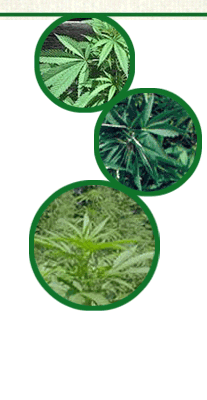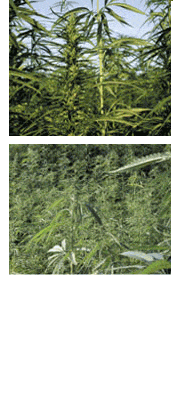

|
Hemp is an annual field crop. It is very productive and has been successfully grown in many different environments - from Finland to South Africa, and Canada to Australia. For this, indeed, hemp can be considered as ubiquitous. Traditionally hemp was grown for its long bast fibres, which were used for producing clothing, linen, ropes and sails. Nowadays the potential applications of hemp are many. This, in addition to the low environmental impact of it cultivation has brought many authors to consider hemp as an extremely interesting crop for the future. Hemp has even been described as a crop that will "save the planet" from deforestation, ozone layer depletion and pollution. Despite the known industrial potential of hemp, it remains as a crop shrouded in suspicion. The suspicion derives from the use of Cannabis as a drug, and this has been the major obstacle hindering the reintroduction of hemp as a fibre crop. Laws governing the growth of hemp proposed fictitious distinctions between hemp strains and this fed doubt and caused disputes on the subject. According to one of the most credited theories, all hemp genotypes belong to the species Cannabis sativa L. with two subspecies, sativa and indica. The only distinctive trait between these two so-called sub-species is the THC (tetra-hydro-cannabinol) content. THC is the chemical substance considered to be responsible for the psychoactive effect of hemp. In the sativa varieties the THC content rarely exceeds 0.4%, while in the Indica varieties it can be as high as 3-4%. In recent years many countries have begun to reconsider the restrictions imposed on hemp cultivation since textile and paper industries have expressed interest in hemp, there is a need to diversify cropping systems and hemp is recognised as a crop that can be grown with minimal negative environmental impact. Scientific research on hemp cultivation, and especially on its processing, has consequently intensified over recent years. Research has also targeted hemp as a natural raw material for replacing petrochemicals. Hemp represents a model crop in the non-food sector, and being well suited for organic agriculture and crop rotation systems it is a viable option for sustainable agricultural systems. In Italy hemp cultivation recommenced in 1998 on approximately 350 ha, an very small area considering that 30 years previously Italy was second in the world after Russia for the are of hemp it cultivated. And with respect to the quality of the products obtained, hemp produced in Italy was the World’s best. Regardless, it was necessary to set up guidelines for its re-launch in order to avoid any mix-up between the fibre and drug varieties. The guidelines were produced by the CIRCOLARE of the Ministry of Agricultural Politics on 2nd December 1997. Today, cannabis sativa can be grown in all the EU member states, though there are strict controls to ensure that the variety sown is on the official list of accepted varieties (EC regulation no.2860/2000, Appendix XII, article 7 bis). Theoretically all varieties recognised by the EC must contain ?0.2% THC. These guidelines brought cultivation under EC control in the same way that the primary processing of the raw material had been. This also means however that both hemp cultivation and primary processing receive a limited but necessary subsidy (as is also given to flax producers).
|


|
| Home | Company | Agricolture
| Industry | Hemp Crop |
Research | Link
| News e Downloads | Italiano Copyright © 2001
- Gruppo Fibranova S.r.l. - Via Antonio Gramsci n° 52 int. 18 - 56031 - Bientina (PI) Italia |